| Part 3 Ait Benhaddou |
|
|
Sunday, November 14. The 4th day.
Left the hotel in Marrakech at 8:30 am.
Our bus is going over Haut Atlas Mountains of more than 3,000 meters to
the south with the sun-filled fall scenery as background.
Then we will visit Ksar of Ait Benhaddou of the World Heritage after the
Tichka Pass of 2,260 meters high.
Our hotel tonight is in the town Ouarzazate at the foot of the mountains
near Sahara Desert.
In the bus, the attendant lady Karimai-san announced, "Do you know
a French Football player called Zinedine? He is a Berber. Ms. Eriko Numajiri's
mother, too."
|
|
| Passing over Haut Atlas |
|
Morocco is divided into north and south by the three mountain ranges from
east to west. They are Middle Atlas of 2000 meters high, Haut (High) Atlas
of 3000-4000 meters high and Anti Atlas of low mountains.
If you name the north side like Marrakech, Fez and Rabat "the modern
cities and Medina (old cities)", it may be able to call the south
side to Sahara Desert "the world of Casbah (Fortresses) and oases".
To that extent, the guidebooks refer to the atmosphere that both the climate
and the culture are different between the north and the south of Atlas
Mountains, which I realized myself during the travel, too.
We experienced the drive over the mountains twice, High Atlas written below
and Moi lyan Atlas 2 days later. |
|
|
I won't forget for a while about the drive over High Atlas from Marrakech to Ouarzazate.
The roads are connected through the mountains including Mt. Toubkel of
4,167 meters high. The highest point is Tichka Pass at an altitude of 2,260
meters.
I am afraid such severe circumstances of the roads are difficult to be
imagined in Japanese common sense.
The total distance was about 200 km, which our large bus went over practically
spending about 4 hours, while we were on the edge of our seats all the
way through.
|
|
|
After Marrakech was away, our bus ran along the road with such fruit trees
as date palms and olives on both sides for a while.
This view might be natural, but next, strange scenery appeared. It was
fields of cactuses and places with their growing in colonies. Their view
came to our eyes in succession.
For what reason were they planted or why did they grow wild here?
This view was different from the one in the West of the United States.
I remembered Joshua Tree National Park south of California during driving
there 40 years ago. Besides, at that time, I met wild spots here and there
across the US, which I will mention in Chapter 10.
Back to this trip, the grazings of sheep around most of the grasslands
were seen and occasionally children of camels, too.
The landscape over the window becomes wastelands and the road goes upward.
We are going up the slope with ocher-colored debris, and the mountains
far away are coming nearer, the shades of which caught our eyes, ..., reddish
brown, light green, white and the same ocher- color of the debris. Some
of them are single-colored and others are like layers of colors.
The wide views themselves change one after another and the drive becomes
more and more thrilling.
For the noted zigzag the speed limit is 60 km per hour. We thought it could
be 40 km at most in Japan.
In comparison with the hillside with a danger of large rocks falling down,
the other side across the road is the edge of a cliff with weak and risky
fences. On the other hand, cars coming and going the hill road seem to
be driving recklessly. I truly doubt that there haven't been any accident.
Just an aside, I noticed many common roads with the speed limit of 80 km
and expressways of 120 km in the whole Morocco.
|
|
|
The scenery, seemingly not knowing such human matters, was magnificent
and calm, which dazzled us while the roads worried us.
Have I ever met such a view of this kind? It is different from those in
Egypt and Turkey. Never like those in Croatia, Slovenia and even the moorland
in the UK. Maybe it's a little like the views seen while driving from Sidney
to Blue Mountains in Australia..., no not.
Emiko and other people are also leaning themselves from the seats. The
panorama views are coming and going over the window.
We took a rest at Tichka Pass for 30 minutes and had a commemorative photo
with the view of 2,260 meters on the background. I bought a small fossil.
The large bus then drove down 2,000 meters with the same thrill as the
ascent.
When Ait Benhaddou of a World Heritage, in the suburbs of Ouarzazate, was
beginning to come nearer, the view told us that the desert was not far.
|
|
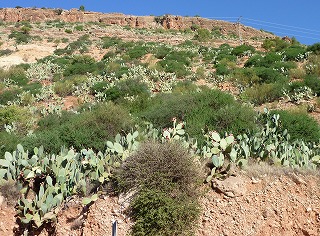 |
|
 |
|
 |
Joshua Tree National Park
Southeast of California,
near the state border with Arizona
(Sep. 9, 1969) |
|
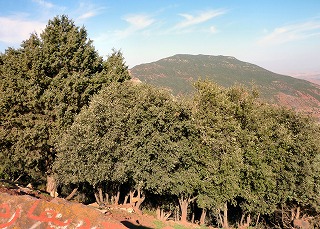 |
|
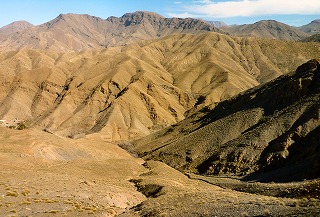 |
|
 |
|
| Ait Benhaddou |
|
|
We drove down the mountain paths completely and saw on the left side the
village like a strange fortress with a shade of reddish brown and ocher
mixed together. It was Ait Benhaddou.
Located 30 km west of Ouarzazate, it is the aggregate of the forts called
Kasbah created in the 16th century, and is said to be collectively called
Ksar (a Kasbah village). It was named after the chief of the tribe firstly
created this Kasbah. Then afterward the same tribes, gathering together,
made neighboring Kasbahs, which totally became this kind of Ksar.
This aggregate itself does not seem to have a special history, but its
peculiar and unrealistic appearance may have made it a World Heritage.
This area from here is callled Kasbah Highway. Around there Kasbas of Berber
residents are dotted. They are said to have been created since 7th century
to avoid the domination of the flooded Arab people.
|
|
 |
|
|
This is probably one pattern of the villages shown as one-time forts, which
is the first strange view to my eyes. Surely more than any expectation.
|
|
|
We got off the bus at the riverbank, and walked on stepping stones across
the shallow and trickling stream with local children's help.
The Ksar, an aggregate of Kasbahs, and various forts with reddish-brown
bricks are just before our eyes.
|
|
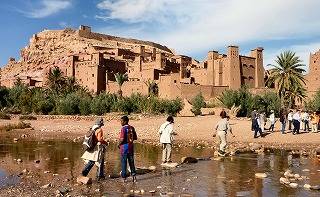 |
|
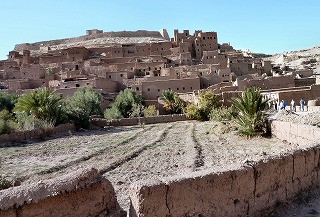 |
|
 |
|
|
Pointing at the left side, the guide says, "This is the location place
of 'Gladiator'".
Was the scene of the fierce fight at the arena filmed here? Though not
quite, the spot directly seen was enough to convince me.
The "Gladiator" was an American movie released ten years ago
in 2000, which wan Academy Award that year. The director was Ridley Scott
with Russell Crowe as a hero character. Especially the powerful battle
scene was impressive, so I remember I was overwhelmed. I saw the movie
at the brand new cinema complex of Ikspiari, Disney Resort in Urayasu City,
near my house.
|
|
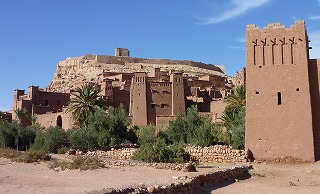 |
|
|
Ridley Scott is one of my favorite movie directors. His movies I remember
now are "Blade Runner", "Black Rain", "Therma
& Louise", "G. I. Jane", "Hannibal" and "Black
Hawk Down".
When I return home after this trip, "Robin Hood" will be on at
Ikspiari. The director and the hero are the same people. So it must be
something. I am looking forward to it.
- - - - -
|
|
|
Back to the filming location, the guide says some other movies were shot
here, like "Lawrence of Arabia", "The Sheltering Sky",
"Sodom and gomorrah", "The Jewel of the Nile", "The
Mummy Returns".
The present residents are, according to the guide, only several. Others
moved to the other new village. Maybe the several remaining families are
in charge of this historic site.
|
|
|
We walk up the steep steps for 30 minutes aiming at the top of the fort.
It is rather tough and shows a maze on the way. A number of the towers
with loopholes are seen.
I almost got out of breath when arrived at the watching stand on the top, where I could see the whole sights all around.
The views are almost a desert, but a couple of green cultivated lands along
the river. On the other hand in the fort, there are a mosque and a graveyard.
This view gives me an imagination of the life style of the past-year village
against any enemies.
Incidentally, I regretted I did not bring a telescope with me. Not only
here in Morocco, it is necessary for a travel.
|
|
 |
|
| We walked down the other stone steps, also with several paths and mazes. |
|
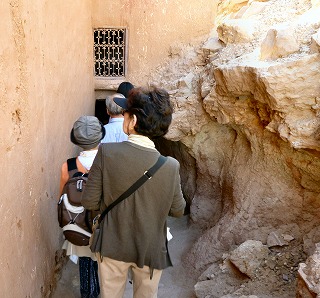 |
|
|
Left Ait Benhaddou, and stopped over in a certain location studio for 10
minutes or so to see something like an entrance.
The guide says it belongs to some movie company in Hollywood. Nobody may
be shooting a movie here now. But this circumstance shows it is active.
Probably a day-off.
We took a snap shot and back on the bus.
|
|
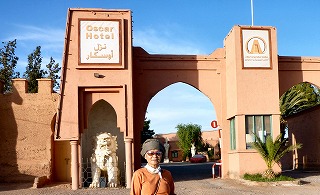 |
|
 |
|
|
We arrived at the hotel in Ouarzazate before 5:00 pm.
Took a slow shower, had a slow dinner. Then relaxed in the room, drank
whisky and water a little, listening to not understandable CNN news. Finally
slept in bed listening to the rakugo of Bunji from the iPod tonight, too.
|
|
| Ait Benhaddou, Other Pictures |
|
| Reading: 16:35 |
|

